Mechanical and Microcrack Evolution Characteristics of Roof Rock of Coal Seam with Different Angle of Defects Based on Particle Flow Code
Abstract
:1. Introduction
2. Methodology
2.1. Particle Flow Code
2.2. Parameter Calibration of Roof Rock of Coal Seam
2.3. Numerical Models Roof Rock of Coal Seam with Different Defects Angle
3. Numerical Simulation and Results
3.1. Strength and Deformation Properties
3.2. Laws of Crack Evolution
3.3. Acoustic Emission Characteristics
3.4. Crack Initiation and Distribution
3.5. Strain Energy Evolution Characteristics
4. Conclusions
Author Contributions
Funding
Institutional Review Board Statement
Informed Consent Statement
Data Availability Statement
Conflicts of Interest
References
- Yang, S.Q. Crack coalescence behavior of brittle sandstone samples containing two coplanar fissures in the process of deformation failure. Eng. Fract. Mech. 2011, 78, 3059–3081. [Google Scholar] [CrossRef]
- Su, H.J.; Jing, H.W.; Zhao, H.H.; Wang, Y.C. Experimental study on the influence of longitudinal fissure on mechanics characteristic of sandstone. J. Min. Saf. Eng. 2014, 31, 644–649. [Google Scholar]
- Cao, P.; Wang, H.; Jin, J.; Cao, R.; Fan, W. Experimental study of the cracks failure of sandstone containing hole and fissure under seepage water pressure. J. China Univ. Min. Technol. 2018, 47, 240–246. [Google Scholar]
- Huang, Y.H.; Yang, S.Q. Particle flow simulation of macro- and meso-mechanical behavior of red sandstone containing two pre-existing non-coplanar fissures. Chin. J. Rock Mech. Eng. 2014, 33, 1644–1653. [Google Scholar]
- Jiang, M.J.; Chen, H.; Zhang, N. Distinct element numerical analysis of crack evolution in rocks containing pre-existing double flaw. Rock Soil Mech. 2014, 35, 3259–3268. [Google Scholar]
- Liu, H.W.; Yang, C. Micro-analysis of uniaxial compression of cracked rock containing open or closing fissure based on PFC. Water Resour. Power 2016, 34, 131–135. [Google Scholar]
- Xu, Y.; Ren, F.; Ahmed, Z.; Wang, K.Y.; Wang, Z.H. Mechanical characteristics and damage evolution law of sandstone with prefabricated cracks under cyclic loading. Arab. J. Sci. Eng. 2021, 46, 10641–10653. [Google Scholar] [CrossRef]
- Wan, W.; Liu, J.; Zhao, Y.; Fan, X. The effects of the rock bridge ligament angle and the confinement on crack coalescence in rock bridges: An experimental study and discrete element method. Comptes Rendus Mec. 2019, 347, 490–503. [Google Scholar] [CrossRef]
- Xu, Y.; Ren, F.; Ahmed, Z.; Wang, K.Y. Mechanical and fatigue damage evolution properties of cracked sandstone under cyclic loading. Proc. Pak. Acad. Sci. 2020, 57, 59–72. [Google Scholar]
- Zhou, X.P.; Bi, J.; Qian, Q.H. Numerical simulation of crack growth and coalescence in rock-like materials containing multiple pre-existing flaws. Rock Mech. Rock Eng. 2015, 48, 1097–1114. [Google Scholar] [CrossRef]
- Aliabadian, Z.; Sharafisafa, M.; Tahmasebinia, F.; Shen, L.M. Experimental and numerical investigations on crack development in 3D printed rock-like specimens with pre-existing flaws. Eng. Fract. Mech. 2020, 241, 107396. [Google Scholar] [CrossRef]
- Zhao, Z.H.; Liu, H.; Gao, X.J.; Feng, Y.H. Meso-macro damage deterioration of weakly cemented red sandstone under the coupling effect of high-humidity and uniaxial loading. Eng. Fail. Anal. 2023, 143, 106911. [Google Scholar] [CrossRef]
- Jiang, M.J.; Zhang, N.; Shen, Z.F.; Chen, H. DEM analyses of crack propagation in flawed rock mass under uniaxial compression. Rock Soil Mech. 2015, 36, 3293–3300. [Google Scholar]
- Luo, K.; Zhao, G.D.; Zeng, J.Z.; Zhang, X.X.; Pu, C.Z. Fracture experiments and numerical simulation of cracked body in rock-like materials affected by loading rate. Chin. J. Rock Mech. Eng. 2018, 37, 1833–1842. [Google Scholar]
- Zhang, B.; Guo, S.; Yang, X.Y.; Li, Y.; Xu, X.J.; Yang, L. Hydraulic fracture propagation of rock-like material with X-type flaws. J. China Coal Soc. 2019, 44, 2066–2073. [Google Scholar]
- Zhang, K.; Liu, X.H.; Li, K.; Wu, W.Y. Investigation on the correlation between mechanical characteristics and fracturing fractal dimension of rocks containing a hole and multi-flaws. Chin. J. Rock Mech. Eng. 2018, 37, 149–158. [Google Scholar] [CrossRef]
- Li, A.; Ma, Q.; Lian, Y.; Ma, L.; Mu, Q.; Chen, J.B. Numerical simulation and experimental study on floor failure mechanism of typical working face in thick coal seam in Chenghe mining area of Weibei, China. Environ. Earth Sci. 2020, 79, 118. [Google Scholar] [CrossRef]
- Yang, S.Q.; Huang, Y.H.; Liu, X.R. Analysis of tensile strength and crack propagation particle flow of discontinuous double fracture rock. J. China Univ. Min. Technol. 2014, 43, 220–226. [Google Scholar]
- Yang, W.; Wei, B.; Xu, Y. Study on the crack growth law and mechanism of the rock mass with defect combination. Geotech. Geol. Eng. 2021, 39, 1319–1327. [Google Scholar] [CrossRef]
- Cao, P.; Liu, T.; Pu, C.; Lin, H. Crack propagation and coalescence of brittle rock-like specimens with pre-existing cracks in compression. Eng. Geol. 2015, 187, 113–121. [Google Scholar] [CrossRef]
- Cao, P.; Zhong, Y.F.; Li, Y.J.; Liu, J. Investigations on direct shear tests and pfc2D numerical simulations of rock-like materials with a hole and prefabricated cracks. Key Eng. Mater. 2014, 627, 477–480. [Google Scholar] [CrossRef]
- Li, D.Y.; Cheng, T.J.; Zhou, T.; Li, X.B. Experimental study on dynamic mechanical failure characteristics of marble with holes under impact loading. Chin. J. Rock Mech. Eng. 2015, 34, 249–260. [Google Scholar]
- Zhao, X.D.; Li, Y.H.; Yuan, R.P.; Yang, T.H.; Zhang, J.Y.; Liu, J.P. Study on crack dynamic propagation process of rock samples based on acoustic emission location. Chin. J. Rock Mech. Eng. 2007, 26, 944–950. [Google Scholar]
- Luo, Y. Influence of water on mechanical behavior of surrounding rock in hard-rock tunnels: An experimental simulation. Eng. Geol. 2020, 277, 105816. [Google Scholar] [CrossRef]
- Li, P.; Rao, Q.H.; Li, Z.; Jing, J. Thermal-hydro-mechanical coupling stress intensity factor of brittle rock. Chin. J. Nonferrous Met. 2014, 24, 499–508. [Google Scholar] [CrossRef]
- Huang, X.; Shi, C.; Ruan, H.N.; Zhang, Y.P.; Zhao, W. Stable crack propagation model of rock based on crack strain. Energies 2022, 15, 1885. [Google Scholar] [CrossRef]
- Sharafisafa, M.; Aliabadian, Z.; Tahmasebinia, F.; Shen, L.M. A comparative study on the crack development in rock-like specimens containing unfilled and filled flaws. Eng. Fract. Mech. 2021, 241, 107405. [Google Scholar] [CrossRef]
- Ma, Z.; Cheng, S.; Gong, P.; Hu, J.; Chen, Y. Particle flow code simulation of the characteristics of crack evolution in rock-like materials with bent cracks. Geofluids 2021, 2021, 8889025. [Google Scholar] [CrossRef]
- Ge, J.J.; Xu, Y.; Huang, W.; Wang, H.B.; Yang, R.Z.; Zhang, Z.Y. Experimental study on crack propagation of rock by blasting under bidirectional equal confining pressure load. Sustainability 2021, 13, 12093. [Google Scholar] [CrossRef]
- Potyondy, D.O.; Cundall, P.A. A bonded-particle model for rock. Int. J. Rock Mech. Min. Sci. 2004, 41, 1329–1364. [Google Scholar] [CrossRef]
- Itasca. PFC (Particle Flow Code) Version 5.0; Itasca Consulting Group Inc.: Minneapolis, MN, USA, 2014. [Google Scholar]
- Castro-Filgueira, U.; Alejano, L.R.; Arzúa, J.; Ivars, D.M. Sensitivity analysis of the micro-parameters used in a PFC analysis towards the mechanical properties of rocks. Procedia Eng. 2017, 191, 488–495. [Google Scholar] [CrossRef]
- Hou, Z.K.; Gutierrez, M.; Ma, S.Q.; Almrabat, A.; Yang, C.H. Mechanical behavior of shale at different strain rates. Rock Mech. Rock Eng. 2019, 52, 3531–3544. [Google Scholar] [CrossRef]
- Xie, H.P.; Peng, R.D.; Ju, Y.; Zhou, H.W. On energy analysis of rock failure. Chin. J. Rock Mech. Eng. 2005, 24, 2603–2608. [Google Scholar]

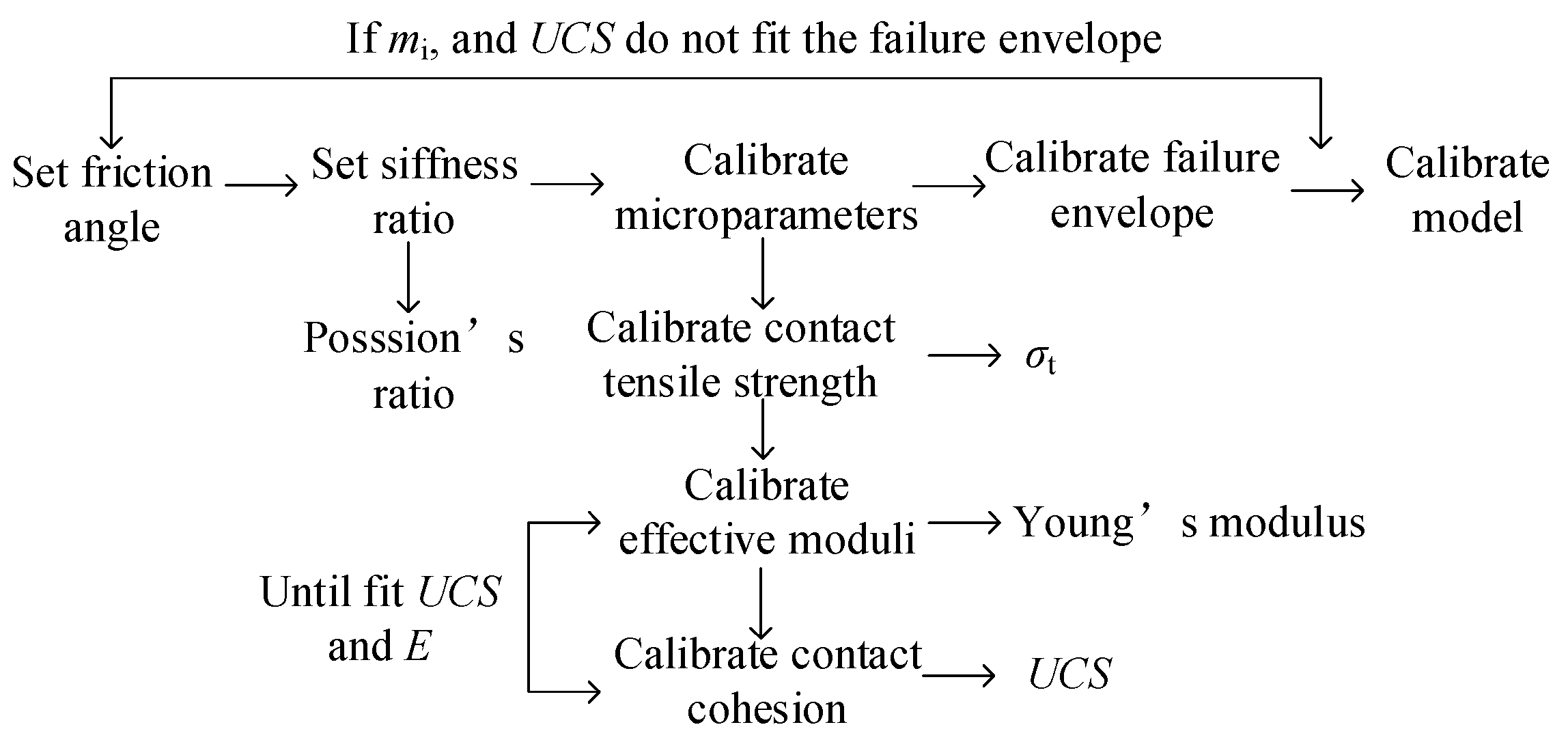

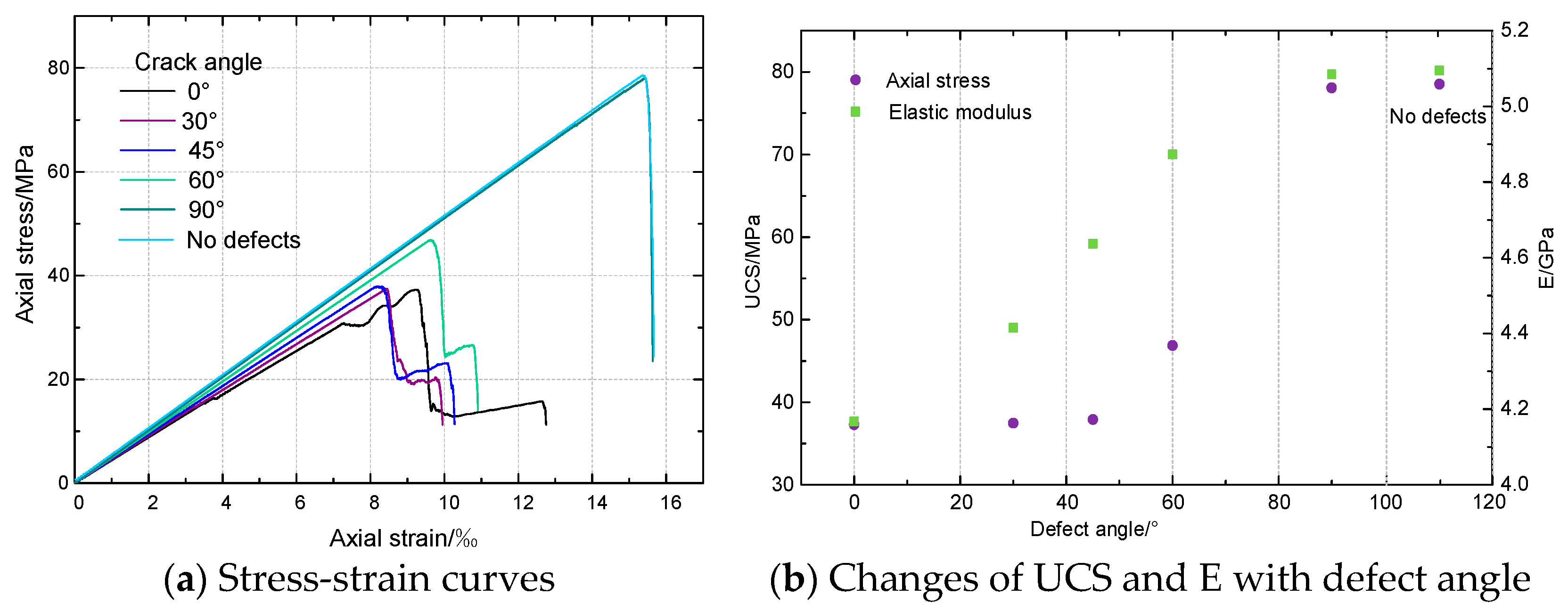
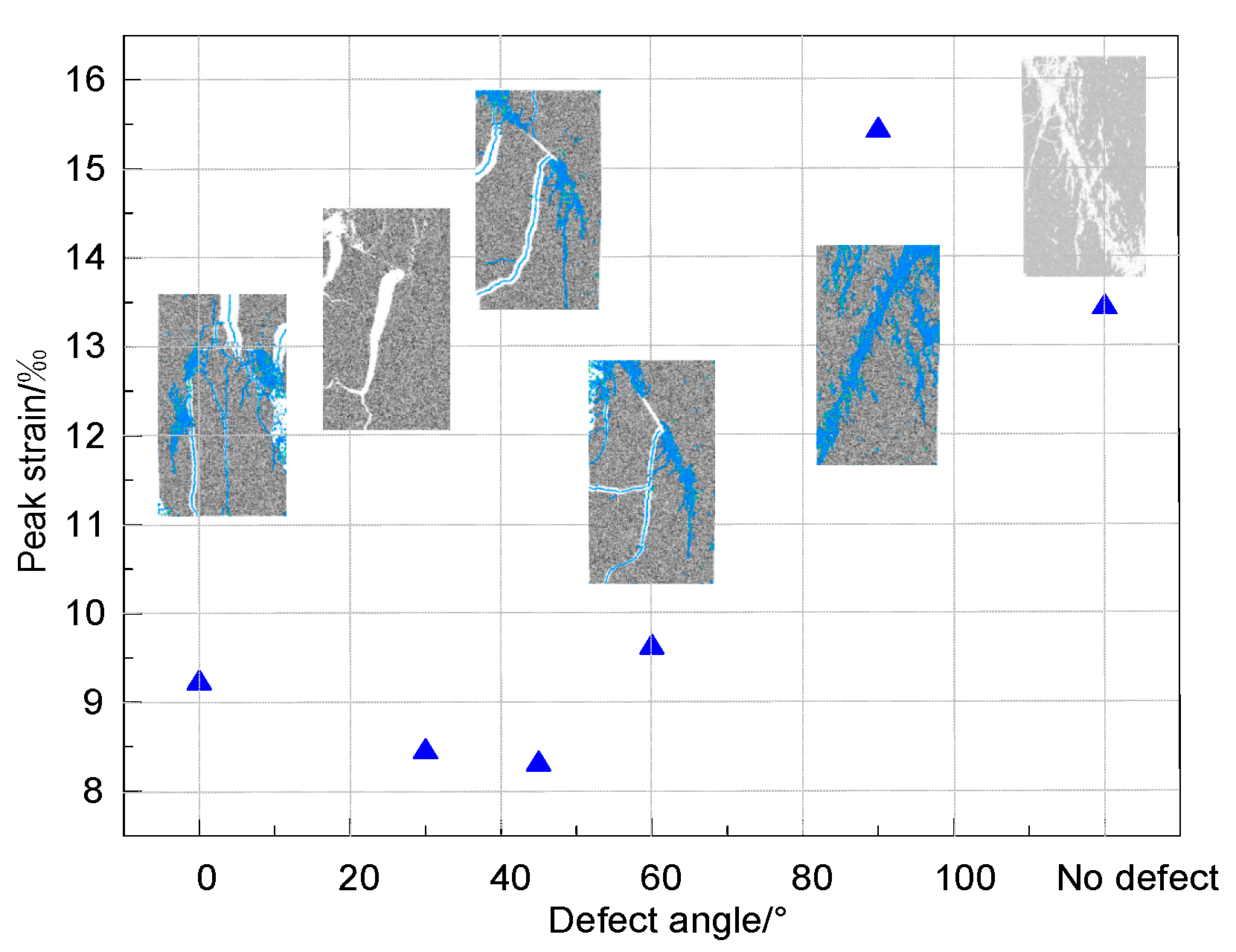
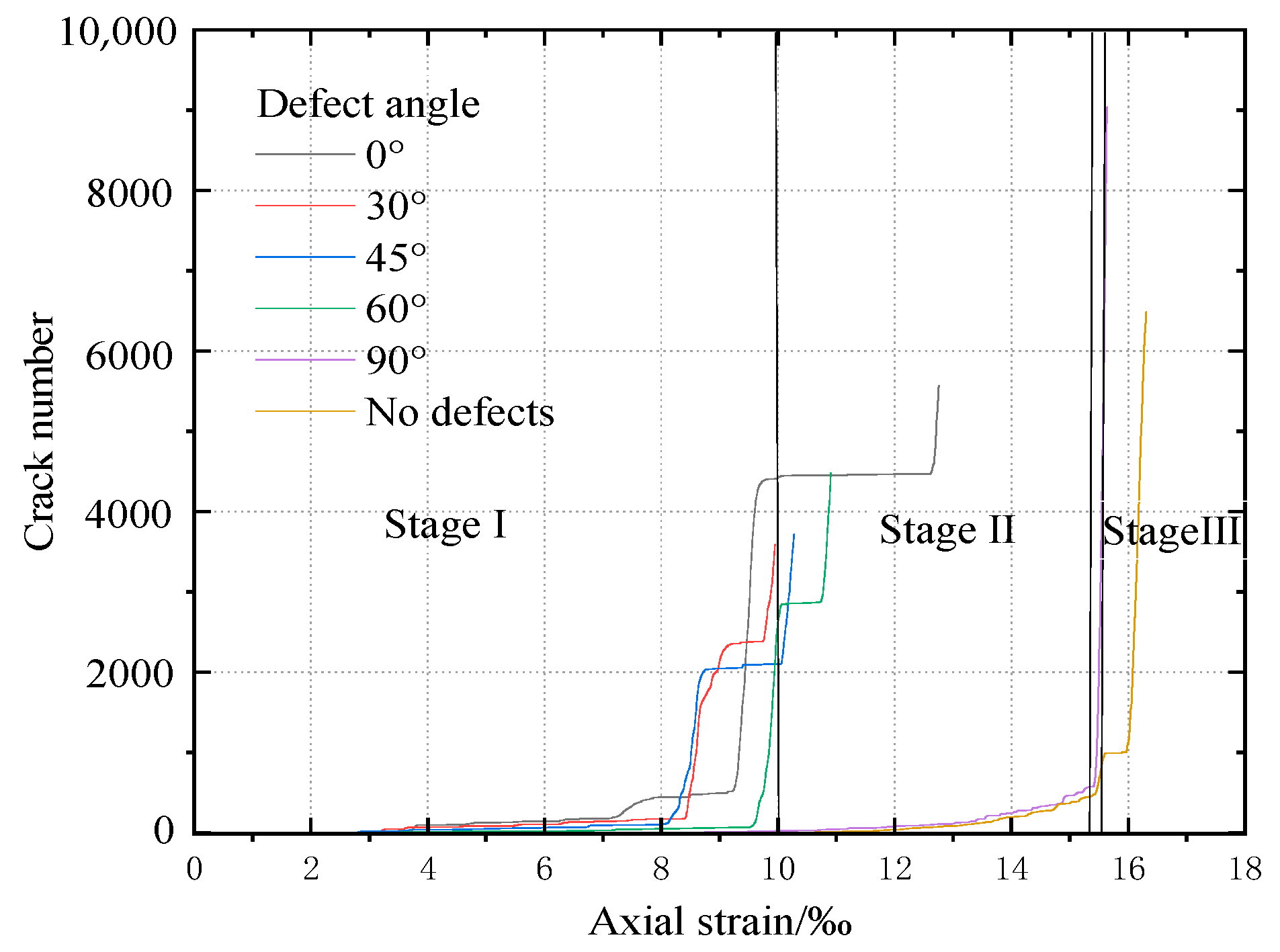
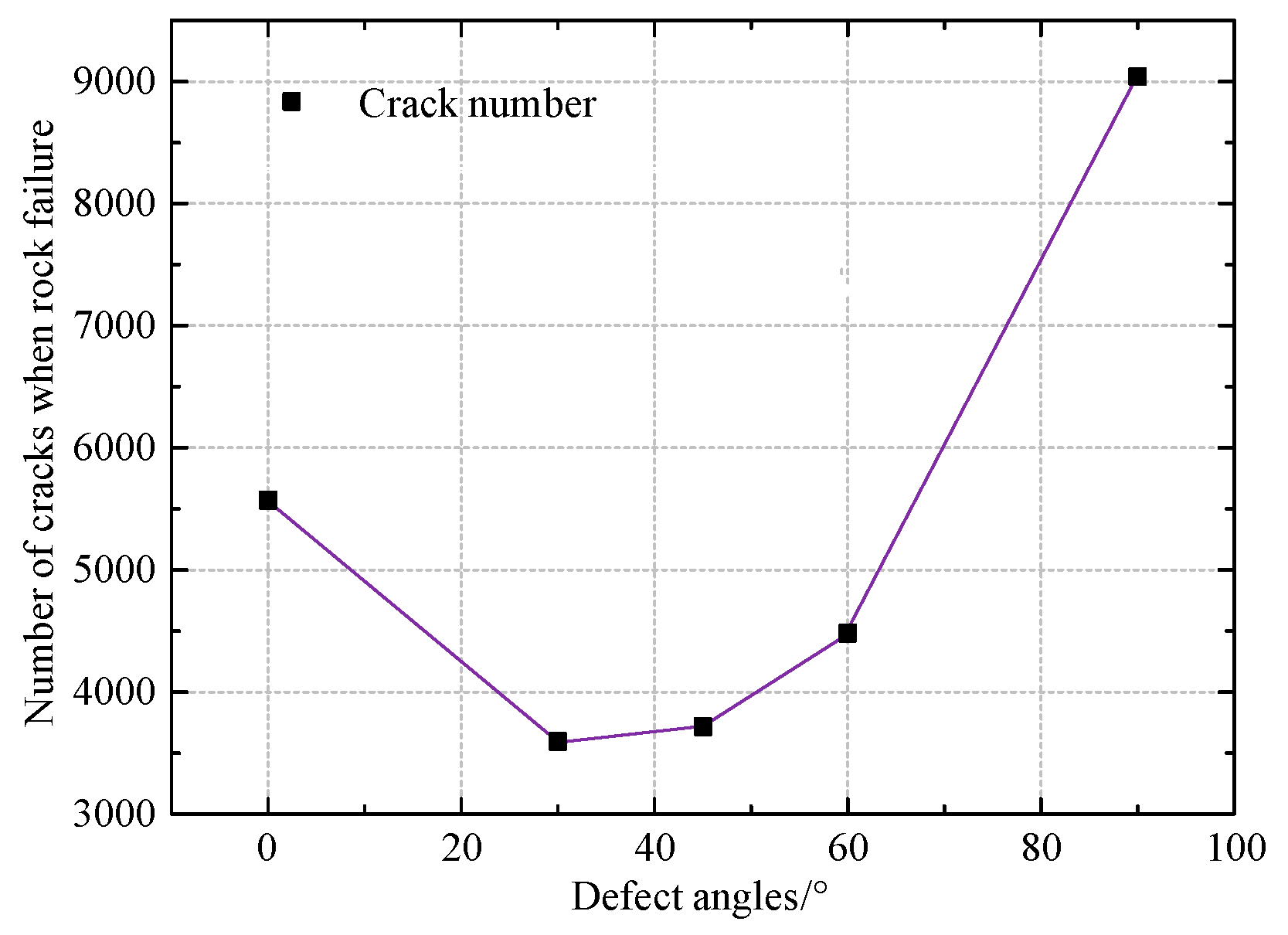



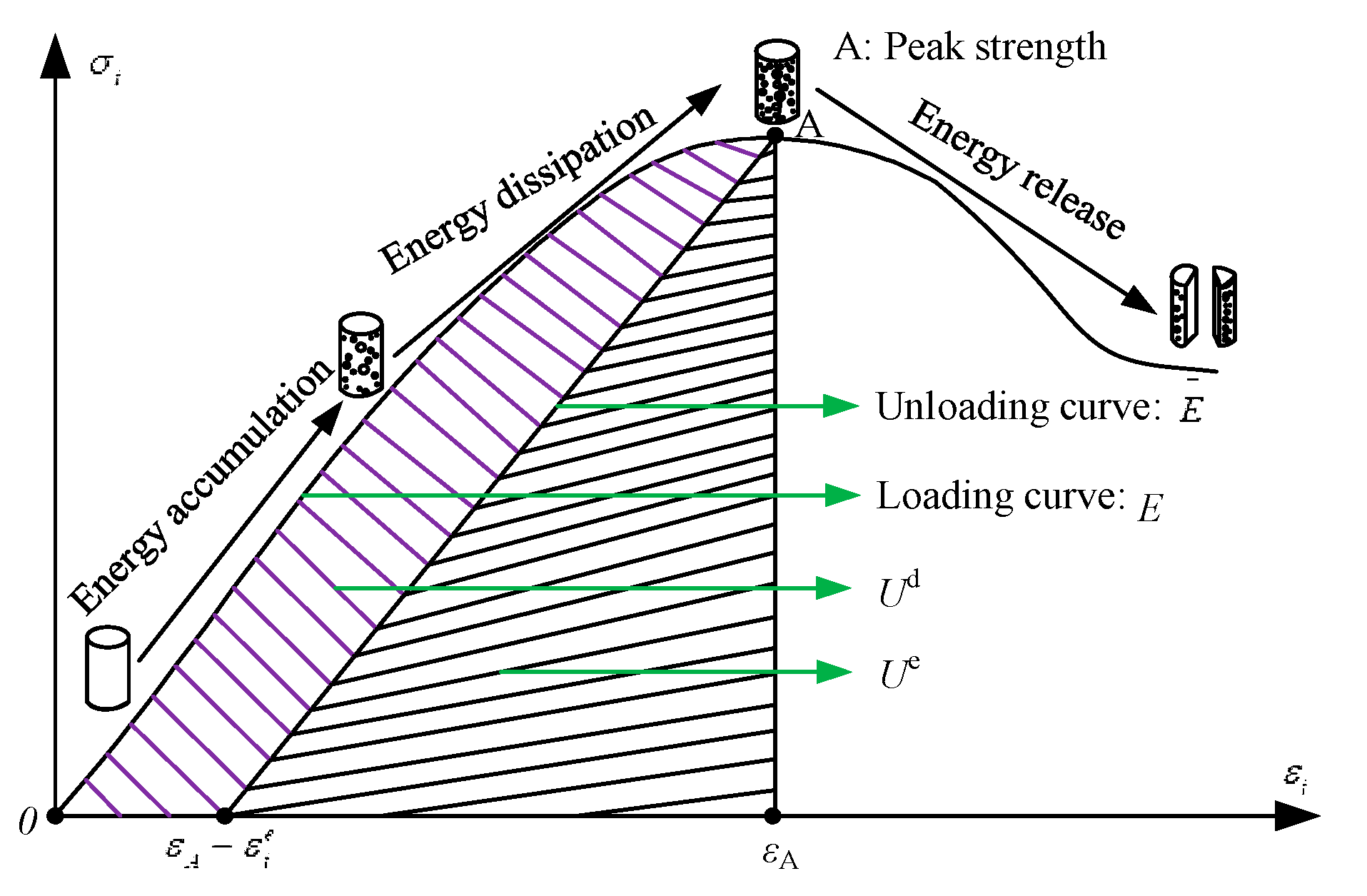
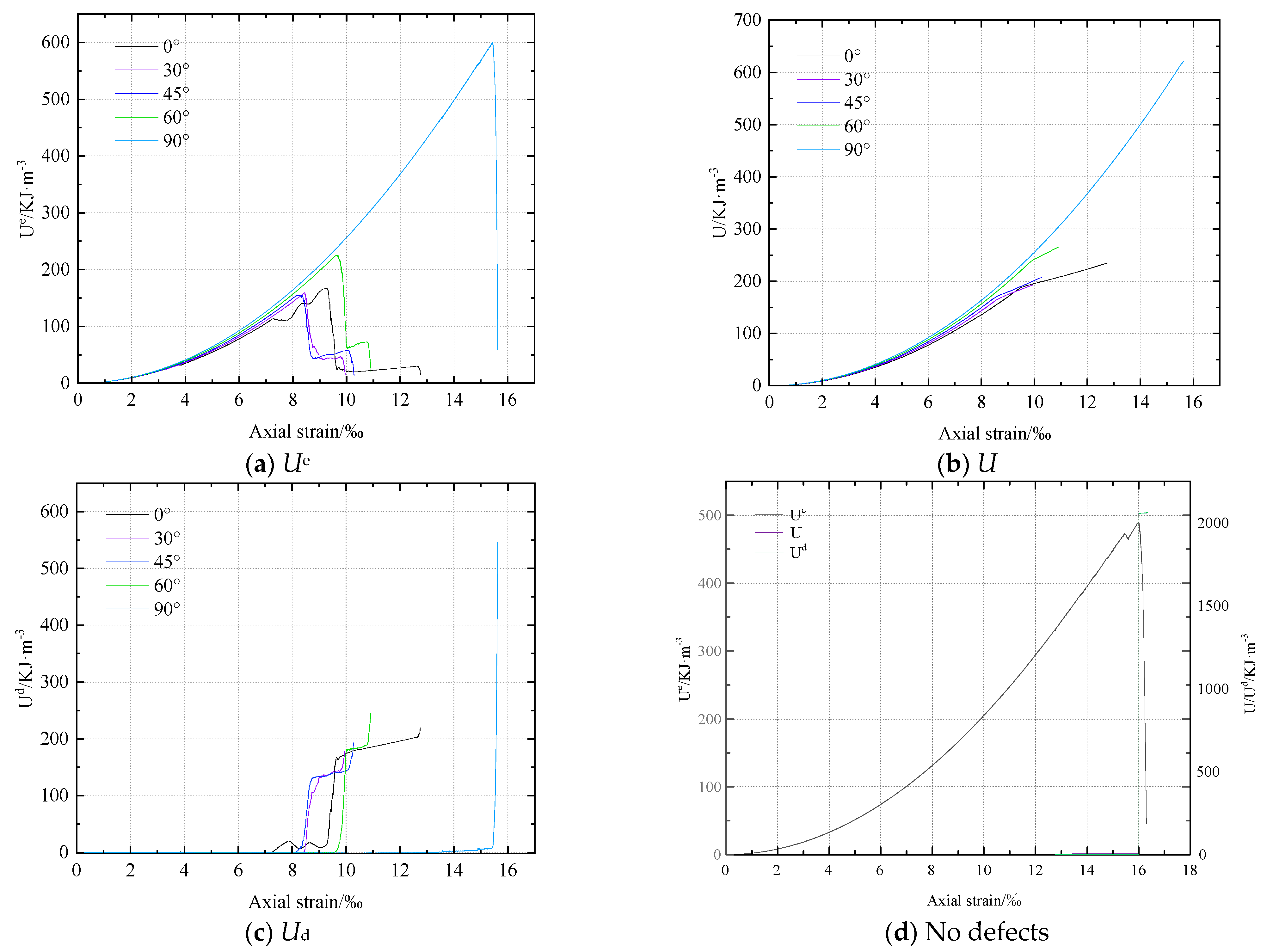
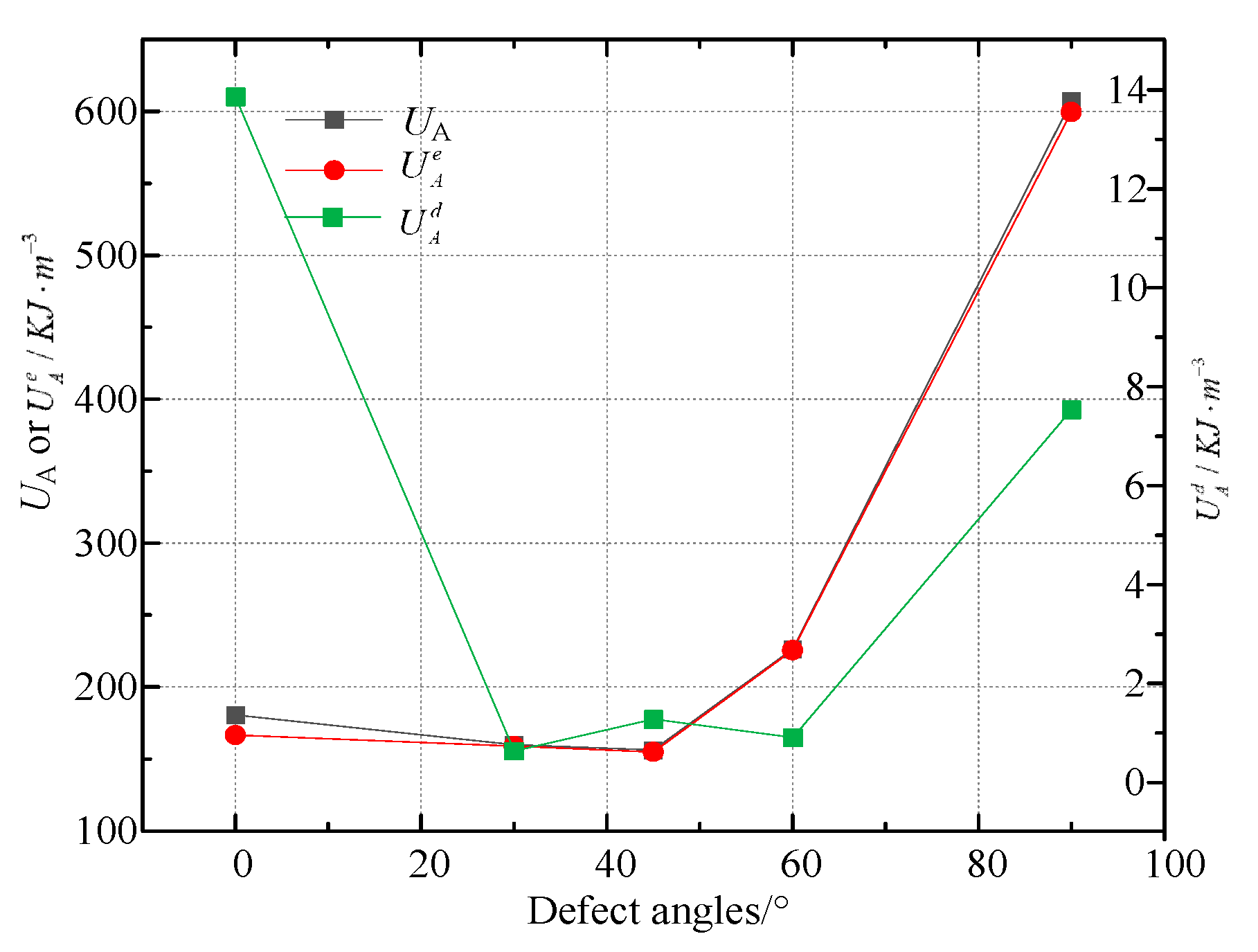
| Contact Parameter | Rock | Meaning |
|---|---|---|
| Rmin | 0.2 | Minimum particle size |
| Rmax/Rmin | 1.5 | Ratio of maximum particle size to minimum particle size |
| Ec (GPa) | 1.8 | Effective modulus of particles |
| Kn/Ks | 1.5 | Ratio of the contact stiffness between the normal direction and the tangential bond of particles |
| (GPa) | 2.4 | Bond effective modulus |
| 1.5 | Ratio of normal to tangential bonding contact stiffness | |
| (MPa) | 16 | Average and standard deviation of normal bond strength |
| (MPa) | 20 | Mean and standard deviation of cohesive force |
| (°) | 42 | Bond internal friction angle |
| 0.5 | Linear friction coefficient of particles |
| Defect Angles/° | UA/KJ·m−3 | ||||
|---|---|---|---|---|---|
| 0 | 180.47 | 166.60 | 13.87 | 92.3 | 7.7 |
| 30 | 159.70 | 159.06 | 0.64 | 99.6 | 0.4 |
| 45 | 156.23 | 154.95 | 1.28 | 99.2 | 0.8 |
| 60 | 226.44 | 225.53 | 0.91 | 99.6 | 0.4 |
| 90 | 607.04 | 599.50 | 7.54 | 98.8 | 1.2 |
| No defects | 583.50 | 489.68 | 93.82 | 83.9 | 16.1 |
Disclaimer/Publisher’s Note: The statements, opinions and data contained in all publications are solely those of the individual author(s) and contributor(s) and not of MDPI and/or the editor(s). MDPI and/or the editor(s) disclaim responsibility for any injury to people or property resulting from any ideas, methods, instructions or products referred to in the content. |
© 2023 by the authors. Licensee MDPI, Basel, Switzerland. This article is an open access article distributed under the terms and conditions of the Creative Commons Attribution (CC BY) license (https://creativecommons.org/licenses/by/4.0/).
Share and Cite
Deng, Q.; Liu, J.; Wang, J.; Lyu, X. Mechanical and Microcrack Evolution Characteristics of Roof Rock of Coal Seam with Different Angle of Defects Based on Particle Flow Code. Materials 2023, 16, 1401. https://doi.org/10.3390/ma16041401
Deng Q, Liu J, Wang J, Lyu X. Mechanical and Microcrack Evolution Characteristics of Roof Rock of Coal Seam with Different Angle of Defects Based on Particle Flow Code. Materials. 2023; 16(4):1401. https://doi.org/10.3390/ma16041401
Chicago/Turabian StyleDeng, Qinghai, Jiaqi Liu, Junchao Wang, and Xianzhou Lyu. 2023. "Mechanical and Microcrack Evolution Characteristics of Roof Rock of Coal Seam with Different Angle of Defects Based on Particle Flow Code" Materials 16, no. 4: 1401. https://doi.org/10.3390/ma16041401
APA StyleDeng, Q., Liu, J., Wang, J., & Lyu, X. (2023). Mechanical and Microcrack Evolution Characteristics of Roof Rock of Coal Seam with Different Angle of Defects Based on Particle Flow Code. Materials, 16(4), 1401. https://doi.org/10.3390/ma16041401





